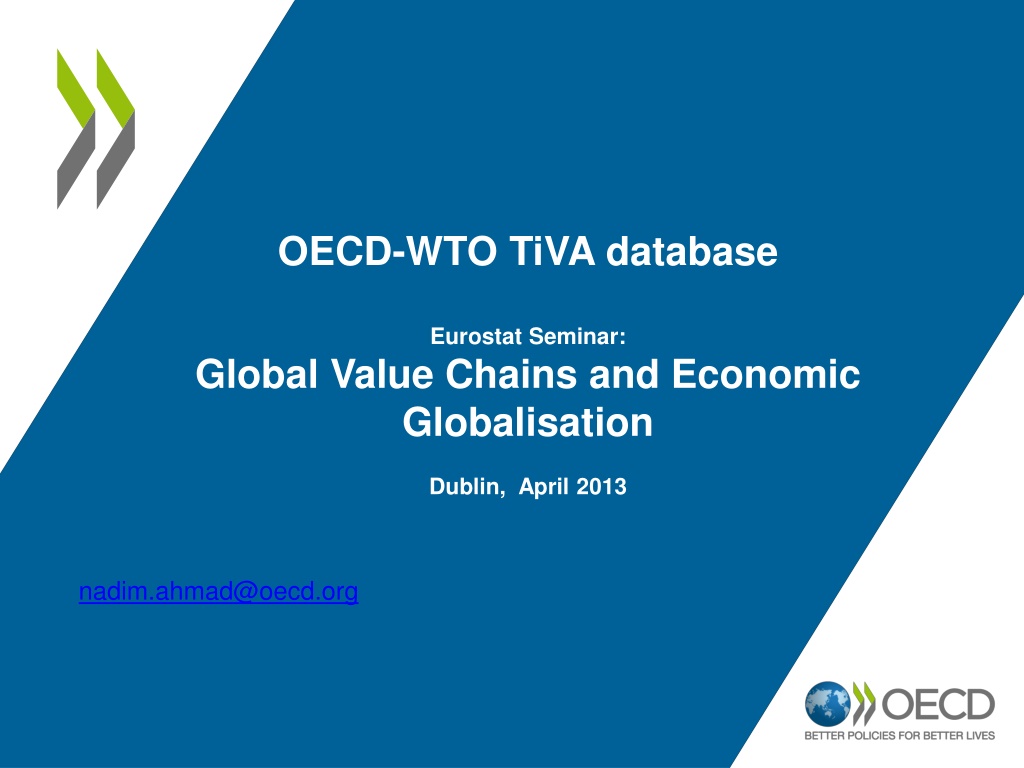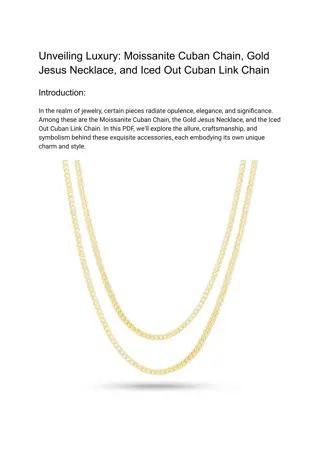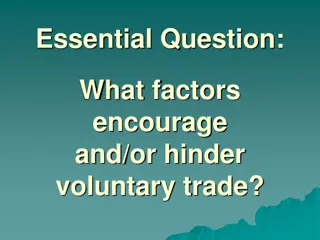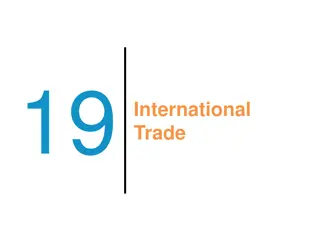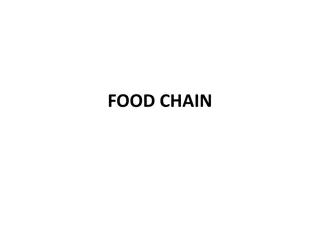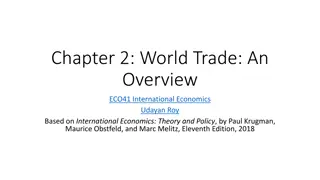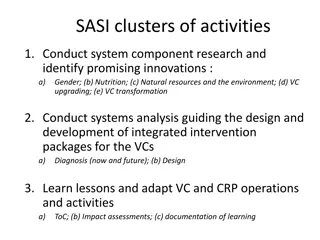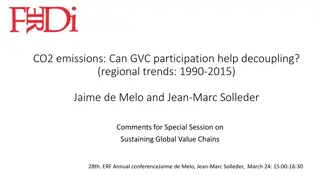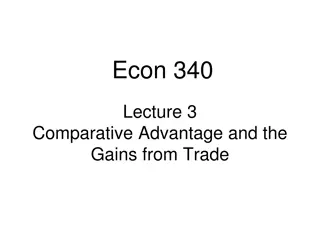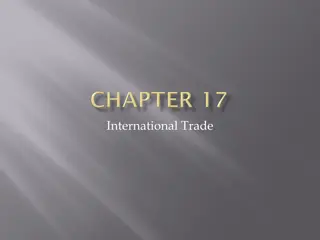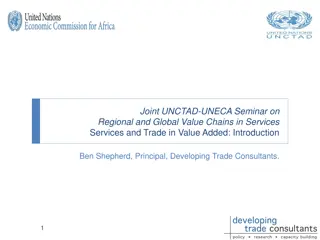Understanding Trade in Value-Added (TiVA) and Global Value Chains
Trade in Value-Added (TiVA) offers crucial insights into the complexities of global value chains and economic globalization. By shifting focus from gross trade statistics to value creation along supply chains, TiVA helps in formulating better policies and addressing systemic risks associated with macro-economic shocks and the integration of emerging economies. Through collaboration and data analysis, TiVA databases provide detailed information on the domestic and foreign content of exports, bilateral trade balances, and more, offering a comprehensive understanding of international trade dynamics.
Download Presentation

Please find below an Image/Link to download the presentation.
The content on the website is provided AS IS for your information and personal use only. It may not be sold, licensed, or shared on other websites without obtaining consent from the author. Download presentation by click this link. If you encounter any issues during the download, it is possible that the publisher has removed the file from their server.
E N D
Presentation Transcript
OECD-WTO TiVA database Eurostat Seminar: Global Value Chains and Economic Globalisation Dublin, April 2013 nadim.ahmad@oecd.org
Background: Increasing international fragmentation of production .Has meant that gross trade statistics may create misleading perceptions and imperfect policies Export driven growth strategies may target the wrong industries and export markets. typically reveal a low contribution made by the service sector (less than 25%), and cannot reveal whose final consumers drive supply Protectionism can be counter-productive Imports can improve competitiveness And imports increasingly embody value originally generated in the importing country. 2
Trade in Value-Added Provides a means to better inform such policies And others .. Systemic risks:- impact of macro-economic shocks on supply-chains Integration of emerging economies in GVCs Bilateral Trade Balances 3
How do we measure TiVA? Using a global IO table 4
What are we doing? Using database on national IO tables to create a global IO table. OECD: IO tables for 58 economies and 37 industries for 1995/2000/2005/2008,2009, (more than 95% of world GDP) Bilateral trade data for the flows; Collaborating closely with: other institutions/initiatives: USITC, IDE-JETRO, WIOD; MOFCOM and forging closer links with others including Eurostat. Launched OECD-WTO TiVA database on 16 January (40 countries 18 industries) 5
A database on OECD.Stat With a number of indicators . Decompositions of gross exports by industries into their domestic and foreign content, with the domestic content split into three (direct, indirect and re-imported) components and the foreign content broken down by source country; The services content of gross exports by exporting industry (broken down by foreign/domestic origin); Bilateral trade balances based on flows of value-added embodied in domestic final demand; Intermediate imports embodied in exports, as a per cent of total intermediate imports. 6
What does the first release tell us? Domestic content of exports 7
Exports require imports Transport equipment Electronics 8
With hubs playing an important role Rest of the world, 4.4% Asia, 3.4% Rest of the world, 5.1% OtherEuro pe, 16.3% Asia, 4.4% OtherEurop e, 14.8% France, 2.1% UK, 2.4% Italy, 3.2% Domestic, 69.1% Domestic, 60.7% US, 3.6% US, 2.4% Germany, 8.2% Germany: Motor vehicles, 2009 France: Motor vehicles, 2009 Rest of the world, 9.9% Rest of the world, 6.1% Other Asia, 6.8% Other Asia, 8.3% Europe, 7.4% Europe, 5.6% Japan, 4.1% Domestic, 40.6% Japan, 9.4% Domestic, 55.4% Chinese Taipei, 4.7% China, 9.6% China, 12.1% US, 20.1% Mexico: Electronics, 2009 Korea: Electronics, 2009 9
And a significant share of total intermediate imports is used in exports 10
Services matter Services Value-Added: % of exports, 2009 Foreign Domestic 90 80 70 60 50 40 30 20 10 0 11
Who trades with who? Japan s trade balances Gross Trade Balance Value Added Trade Balance 40000 30000 20000 10000 0 -10000 -20000 Rest of the World Australia Indonesia Russian federation United Kingdom Germany Canada India Korea China United States 13
Whilst there are limitations to the widespread calculation of trade in value-added data, the OECD-WTO initiative is to be applauded for providing a more revealing look into global trade and integration and for paving the way for further development in this area. 15
A work in progress Results are estimates designed to highlight 2 key issues the need for policies to account for GVCs the importance of capacity building and better statistics Improving data quality is essential Coherent estimates of trade in goods and services A new approach to Supply-Use Tables? With a focus on stages and trade rather than industries, per se, to better reflect firm heterogeneity (particularly MNEs). Import/export intensities, factoryless firms, processors, ownership But this is, probably, longer term? 16
What can be done now? Improved GROSS trade data Import flow matrices Better bilateral trade statistics (integrated with SU tables) and globally consistent Intelligent confidentiality rules (suppress 6 digit not 2 digit HS) Re-export data Second hand goods, scrap and waste. SERVICES EBOPS 2012. 17
What else can be done..now? Capitalise on existing data to create new indicators on exporting and importing firms Beyond TEC: Linking trade registers, business registers and SBS Workshop on linking business and trade statistics: 25-26 October 2012 Exploring feasibility of creating new indicators based on export (and import) intensities, ownership and size. And also provides stepping stone for trade in income Changes to classification systems to better reflect globalisation: Factoryless producers (Task Force on Global Production 18
Extensions Trade in jobs and skills But requires Coherent employment and value-added data Also important for productivity estimates And significant improvement in skills data (and occupations) Trade in Income: Ownership matters: Because value added does not always stick (compensation for use of knowledge based assets where increasingly registration is determined by tax environment) And because flows for use of IPPs are often recorded as property income and not trade in services. Need better FATS data, particularly on value-added and employment. MSITS 2010 Compilers Guide 19
Summary Whats needed New thinking on SU tables Better gross trade data Links to microdata Income, Ownership and FATS 20
Future events MCM May 2013: Comprehensive report on policy implications of GVCs: covering trade policy, investment policies and other domestic policies aimed at drawing benefits from engagement in GVCs. TiVA event and new data release including Data on jobs (for some countries). 57 countries 1995, 2000. And new indicators Conference on measurement, Autumn 2013 21
Further information www.oecd.org/trade/valueadded Video: http://www.youtube.com/watch?feature=pl ayer_embedded&v=RZKX-0SK41U 22
